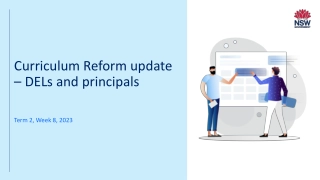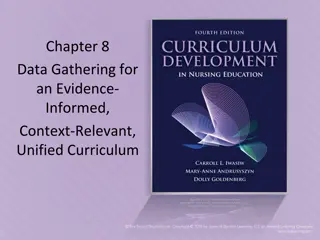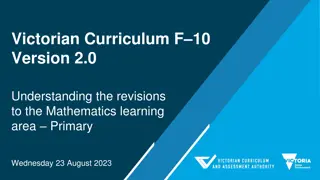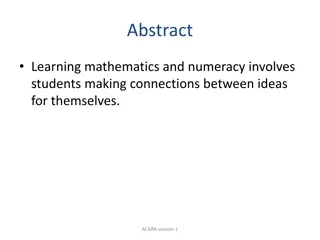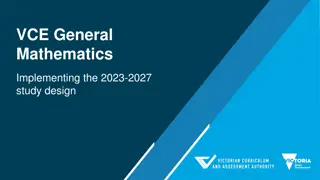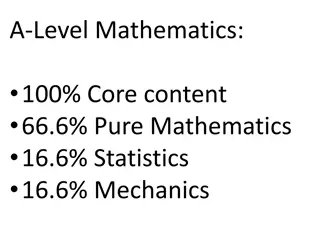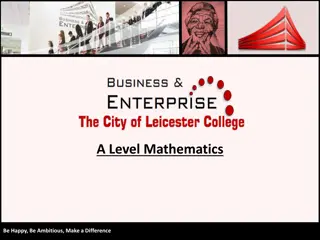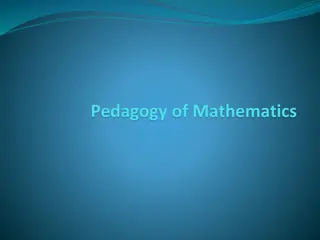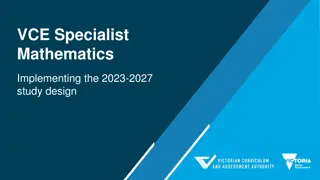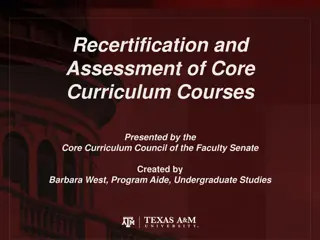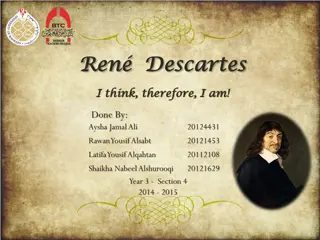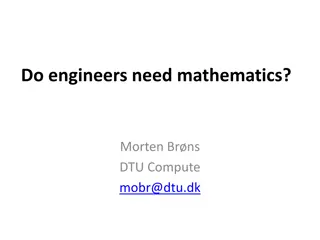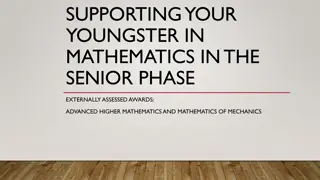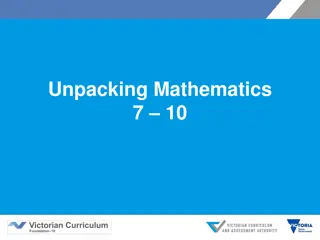High-level Changes in Mathematics Curriculum
The Victorian Curriculum F-10 Version 2.0 brings significant revisions to the Mathematics learning area from Foundation to Level 8. The updated curriculum aims to equip students with essential mathematical and numeracy skills for everyday life, empowering them to become confident users of mathematics who can think critically, communicate effectively, and solve problems across various fields. It encourages students to develop a positive attitude towards mathematics, appreciate its history and applications, and make connections between different mathematical concepts. With phased implementation scheduled from 2024 onwards, this updated curriculum aims to enhance students' proficiency in mathematics and foster critical thinking skills in problem-solving.
Uploaded on Mar 10, 2025 | 0 Views
Download Presentation

Please find below an Image/Link to download the presentation.
The content on the website is provided AS IS for your information and personal use only. It may not be sold, licensed, or shared on other websites without obtaining consent from the author.If you encounter any issues during the download, it is possible that the publisher has removed the file from their server.
You are allowed to download the files provided on this website for personal or commercial use, subject to the condition that they are used lawfully. All files are the property of their respective owners.
The content on the website is provided AS IS for your information and personal use only. It may not be sold, licensed, or shared on other websites without obtaining consent from the author.
E N D
Presentation Transcript
Victorian Curriculum F10 Version 2.0 Mathematics High-level changes between the Victorian Curriculum F 10 Version 1.0 and Version 2.0, Foundation to Level 8
Overview Timeline and aims Revisions to the Mathematics learning area Foundation to Level 8 The 4 mathematical processes VCAA resources
Implementation timeline Victorian Curriculum F 10 Version 2.0 Mathematics published 28 July 2023 Phased implementation from 2024 onwards: Victorian government and Catholic schools can implement from 2024, with full implementation in 2025 Implementation in independent schools is at the discretion of each school in the sector 2022 2023 2024 2025 Familiarisation Full Revision Familiarisation implementation Mathematics Start implementation (optional)
Mathematics Version 2.0: Aims Mathematics aims to ensure that students: develop useful mathematical and numeracy skills for everyday life and work, as emerging active and critical citizens in a technological world become confident, proficient, effective and adaptive users of mathematics become effective communicators of mathematics who can investigate, represent and interpret situations in their personal and work lives, think critically, and make choices as active, engaged, numerate citizens develop proficiency with mathematical concepts, skills, procedures and processes, and use them to demonstrate mastery in mathematics as they pose and solve problems, and reason with number, algebra, measurement, space, statistics and probability
Mathematics Version 2.0: Aims continued make connections between areas of mathematics and apply mathematics to model situations in various fields and disciplines develop a positive disposition towards mathematics, recognising it as an accessible and useful discipline to study appreciate mathematics as a discipline its history, ideas, problems and applications, aesthetics and philosophy
Revisions to the Mathematics learning area Foundation to Level 8
Overview of structural changes Mathematics Version 2.0: organises content under 6 strands: Number, Algebra, Measurement, Space, Statistics and Probability (from Level 3) with no sub-strands embeds the proficiencies in achievement standards and content descriptions includes greater emphasis on the 4 mathematical processes of mathematical modelling, computational thinking and simulations, statistical investigation, and probability experiments and simulations in content descriptions across the strands includes better-aligned achievement standards and clearer content descriptions provides improved sequencing of concepts, with stronger links across strands includes play- and exploration-based content positioned from Foundation to Level 2 provides enhanced clarity through: level descriptions that outline in greater detail the content, skills and expected outcomes at each level content descriptions with clearer articulation of the essential mathematical facts, procedures and skill elaborations with more examples.
Proficiencies Fluency At each level, the 4 proficiencies of Understanding, Fluency, Reasoning and Problem-solving have been embedded in achievement standards and content descriptions, which now more clearly articulate the proficiencies. Strands Reasoning Understanding Problem- solving
Proficiencies in content descriptions Content description clarity has been improved so that content descriptions more clearly articulate the proficiencies. Level 3 Algebra Level 4 Number extend and apply knowledge of addition and subtraction facts to 20 to develop efficient mental strategies for computation with larger numbers without a calculator choose and use estimation and rounding to check and explain the reasonableness of calculations, including the results of financial transactions VC2M3A02 VC2M4N07 Proficiencies: Understanding, Fluency Proficiencies: Reasoning, Problem-solving
Proficiencies in achievement standards The following extracts from the Level 3 and Level 4 achievement standards correspond to the 2 content description examples from the previous slide. Level 3 achievement standard extract Level 4 achievement standard extract Students extend and use single-digit addition and related subtraction facts and apply additive strategies to model and solve problems involving two- and three-digit numbers. They choose rounding and estimation strategies to determine whether results of calculations are reasonable. Proficiencies: Understanding, Fluency Proficiencies: Reasoning, Problem-solving
The 6 strands 6 strands Number Algebra Measurement Space Statistics Probability The dual strands have been decoupled now 6 individual strands
Connecting content across strands Level 4 Number Measurement Unit possibilities Content description recognise and extend the application of place value to tenths and hundredths and use the conventions of decimal notation to name and represent decimals use scaled and digital instruments to interpret unmarked and partial units to measure and compare lengths, masses, capacities, durations and temperatures, using appropriate units Connecting decimal numbers with subdivisions of measurement scales for length, temperature and capacity. Explore scales and subdivisions. VC2M4N01 VC2M4M01 Compare measures and equivalence, e.g. 0.5 metre = 50 centimetres 0.8 litre = 800 millilitres 1.5 kilogram = 1500 grams Achievement standard extract Students use appropriate scaled instruments and appropriate units to measure length, mass, capacity and temperature. students use their understanding of place value to represent tenths and hundredths in decimal form and to multiply natural numbers by multiples of 10.
Scope and sequence: Number Level 5 Level 6 Level 7 Level 8 Content descriptions use mathematical modelling to solve practical problems involving additive and multiplicative situations, including simple financial planning contexts; formulate the problems, choosing operations and efficient mental and written calculation strategies, and using digital tools where appropriate; interpret and communicate solutions in terms of the situation use mathematical modelling to solve practical problems involving rational numbers and percentages, including in financial contexts; formulate the problems, choosing operations and using efficient mental and written calculation strategies, and using digital tools where appropriate; interpret and communicate solutions in terms of the situation, justifying the choices made use mathematical modelling to solve practical problems involving rational numbers and percentages, including financial contexts such as best buys ; formulate problems, choosing representations and efficient calculation strategies, designing algorithms and using digital tools as appropriate; interpret and communicate solutions in terms of the situation, justifying choices made about the representation VC2M7N10 use mathematical modelling to solve practical problems involving rational numbers and percentages, including financial contexts involving profit and loss; formulate problems, choosing efficient mental and written calculation strategies and using digital tools where appropriate; interpret and communicate solutions in terms of the context, reviewing the appropriateness of the model VC2M5N09 VC2M6N09 VC2M8N06
Overview of key Levels F8 revisions The revised Mathematics curriculum has reduced the total number of content descriptions in Foundation to Level 10 from 286 to 257. As part of this process, some content descriptions were combined and realigned within and across strands and levels, resulting in various extents of change. To support schools and teachers, the VCAA has provided a range of resources documenting the changes between Victorian Curriculum F 10 Version 1.0 and Victorian Curriculum F 10 Version 2.0.
Overview of key Levels F8 revisions Main content shifts Probability now commences at Level 3 Level 2: recognise and describe one half as one of 2 equal parts of a whole (previously at Level 1) tell time to the half-hour (previously at Level 1) Level 3: explore the connection between addition and subtraction (previously at Level 2) describe the features of 3-dimensional objects (previously at Level 2)
Overview of key Levels F8 revisions Main content shifts Level 4: approximating the area of shapes, using appropriate informal and formal units (previously at Level 2) Level 5: introduction of percentages (previously at Level 6) Level 6: number properties: associative, commutative and distributive laws (previously at Level 7) recognise that probabilities range from 0 to 1 (previously at Level 5)
Overview of key Levels F8 revisions Main content shifts Level 7: formal calculation of volume (previously at Level 5) volume of prisms using appropriate units (previously at Level 8) relationship between and circumference (previously at Level 8) increased focus on the distribution of data, commenting on the shape, centre and spread, including outliers and determining the range, median, mean and mode (previously at Level 8) Level 8: solving one-variable inequalities (realigned from Levels 9 and 10) connecting volume and capacity (previously at Level 6) introduction of Pythagoras theorem (previously at Level 9)
Content realigned down levels In the first year of implementation, content moved down a level will need to be covered at both levels. Victorian Curriculum F 10 Version 1.0 Victorian Curriculum F 10 Version 1.0 explore the use of brackets and order of operations to write number sentences (VCMNA220) apply the associative, commutative and distributive laws to aid mental and written computation and make estimates for these computations (VCMNA240) make connections between equivalent fractions, decimals and percentages (VCMNA217) Level 7 to Level 6 Level 6 to Level 5 Victorian Curriculum F 10 Version 2.0 Victorian Curriculum F 10 Version 2.0 recognise that 100% represents the complete whole and use percentages to describe, represent and compare relative size; connect familiar percentages to their decimal and fraction equivalents (VC2M5N04) find unknown values in numerical equations involving brackets and combinations of arithmetic operations, using the properties of numbers and operations (VC2M6A02)
VCAA resource detailing revisions The comparison of curriculums document details the changes between Mathematics Version 1.0 and Version 2.0. It maps Version 1.0 content descriptions to the corresponding Version 2.0 content descriptions.
The 4 mathematical processes
Process: Mathematical modelling Develop mathematical model or formulate problem Real-world or theoretical context Apply mathematical model or use problem-solving strategies and techniques Interpret results and refine model or problem and approaches
Mathematical modelling Decide on event and fundraising target Level 5 Number Content description Develop budget model Problem: Budgeting for a class fundraising event use mathematical modelling to solve practical problems involving additive and multiplicative situations, including simple financial planning contexts; formulate the problems, choosing operations and efficient mental and written calculation strategies, and using digital tools where appropriate; interpret and communicate solutions in terms of the situation Apply model to predict costs and earnings Interpret solution in terms of target VC2M5N09
Process: Computational thinking Abstraction Decomposition Algorithm development Pattern recognition
Computational thinking Input operation output Try different inputs and operations Level 6 Algebra Content description Using an algorithm to generate a set of numbers design and use algorithms involving a sequence of steps and decisions that use rules to generate sets of numbers; identify, interpret and explain emerging patterns Describe emerging patterns VC2M6A03 Develop algorithm
Process: Statistical investigation Pose a question Collect data Interpret and communicate results Analyse data
Statistical investigation Develop question Level 4 Statistics Create survey and collect data from students Content description Question: What is the preferred movie choice for the class? conduct statistical investigations, collecting data through survey responses and other methods; record and display data using digital tools; interpret the data and communicate the results Represent data VC2M4ST03 Interpret data and report back to the class
Process: Probability experiments and simulations Devise experiment or simulation Pose chance question Analyse and interpret results Run experiment or simulation
Probability experiments and simulation Develop chance question Level 3 Probability Devise experiment Question: How often does a colour occur in a set of trials with a spinner? Content description conduct repeated chance experiments; identify and describe possible outcomes, record the results, and recognise and discuss the variation Repeat experiment and tally frequencies VC2M3P02 Discuss variation in results
Understanding the revised curriculum The VCAA has prepared a range of resources to support teachers in understanding the revised curriculum: Introducing Mathematics Version 2.0 Mathematics comparison of curriculums document (Version 1.0 to Version 2.0) Mathematics Version 2.0 scope and sequence documents a glossary of mathematical terms used in the revised curriculum downloadable Word version of the Mathematics Version 2.0 curriculum
Planning for the revised curriculum The VCAA has prepared a range of resources to support teachers in planning for implementation of the revised curriculum, including: Mathematics Teacher Guide (Prep 10) Mathematics Learning Area Leader Guide (Prep 10) teaching and learning unit template example teaching and learning units for Levels 3 and 8 example assessment tasks that address specific aspects of the revised achievement standards for Levels 3 and 8 other planning templates and examples, such as curriculum area maps and curriculum area plans.



